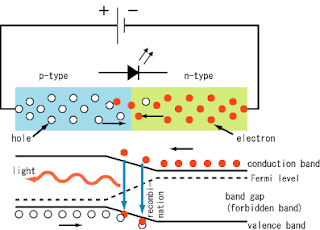I got into an LED vs CFL conversation in a meeting today. Which technology is really appropriate for us in the Philippines? To answer this question, we ought to examine each technology.
What is an LED? The name, Light Emitting Diode, says a lot. First, the device is a diode. Which means it lets current pass under a when the positive and negative terminals are connected one way (forward bias) but nothing terminals are reversed (reverse biased). Second, it means that light is produced as it goes through this process. The device construction is simply a junction of unlike semiconductor materials (i.e. PN junction). When the device is unconnected, a electric field exists because of the interactions of charges on semiconductor and that of introduced impurities. In a forward bias condition, the field facilitates the movement of charges across the junction, thus the current. As charges(i.e. electrons, negative charge) move in one direction, they meet "particles" (holes, positive charge) with opposite charge and direction. When electrons and holes meet light is produced as the electron moves to a lower energy state. This process is called photoluminescence. The photovoltaic phenomenon an the opposite process to photoluminescence.

LED Mechanism: image taken from wikipedia
CFLs on the other hand, are socket type versions of Fluorescent tubes. The technology is simple. Electrons come is from a terminal and collide with gas molecules in the tube. The molecules go to a higher energy state then go down immediately to achieve stability. As the molecules seek stability, they emit light in the UV range. The UV waves hit the coatings on the tube walls, causing it to Fluoresce. The gas is a mixture of mercury vapor and other noble gases.

CFL: image taken from wikipedia
The main argument against CFL is the mercury while LEDs are always hit with cost and directional capability. Which one is appropriate? A CFL bulb only has 4.0mg mercury or 40% of mercury coming from the usage of an incandescent if power came solely from coal plants. In the Philippines, it would probably be the same but the financial savings and the avoidance of CO2 emissions would merit CFL use. The ADB estimates that switching 1M CFLs would result to about $47M savings due to avoidance of new power plant installation. Philippine government and the ADB are gearing for piloting the worlds first efficient lighting project under the clean development mechanism. CFL was chosen, considering affordability which is crucial to the long term sustainability of the project. This is to note that a significant percentage of the population are below poverty line. Since this is under CDM, waste handling would be something that would be considered in the approval process. Folks from 1st world countries may yap about the evils of CFL but until the cost of LEDs go down this is the only accessible solution. Instead of us harping about CFLs, lets do something to make LEDs affordable and accessible to the poor.




0 comments
Post a Comment